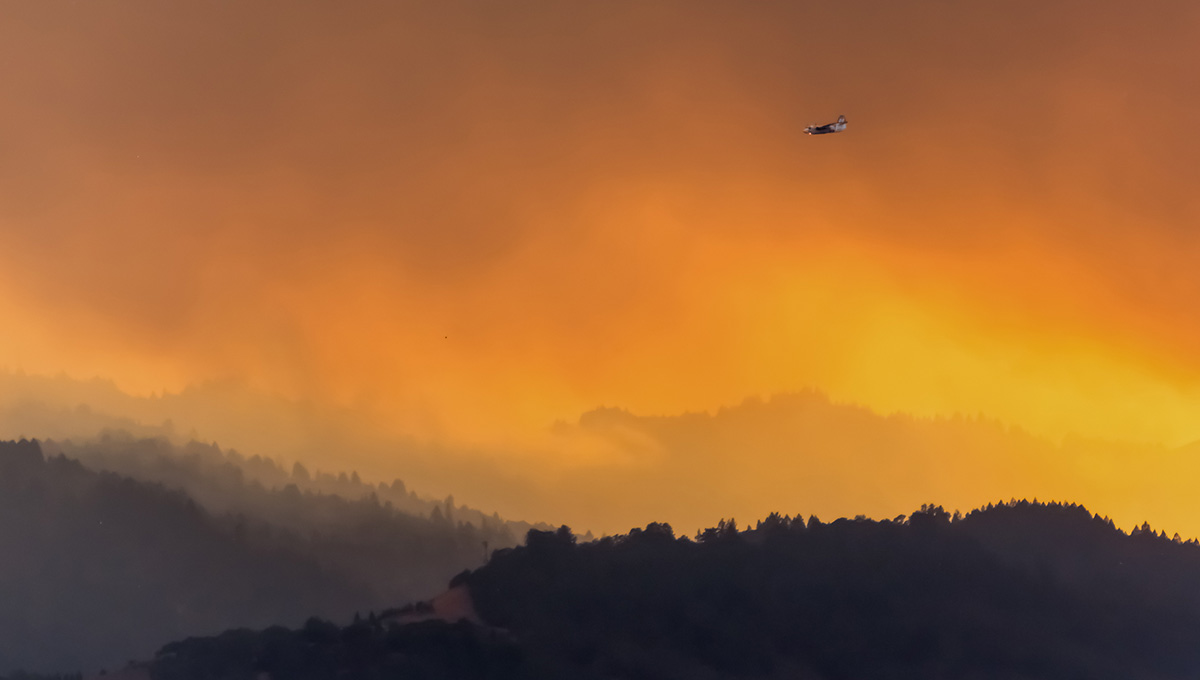With nearly 10,000 fires and over 4.2 million acres – or about 4 percent of the state – burned, 2020 was the largest wildfire season recorded in California’s history. There were more than 10,000 structures damaged or destroyed and a staggering 33 fatalities. Although responding to this level of unprecedented devastation to people, places and property would be challenging in any year, efforts to combat the fires were complicated by the global COVID-19 pandemic.
Samuel R. Wallis, the Community Alert and Warning Manager of Sonoma County Department of Emergency Management, is all too familiar with the additional stress 2020 put on emergency response resources. Sonoma County encompasses more than 1,500 square miles, and Wallis and his team are responsible for alerting the entire county about imminent wildfire dangers, evacuation and safety plans.
Wallis didn’t think it could get much worse than the critical events he witnessed in 2017. That year, the Nuns Wildfire destroyed 1,527 structures and took three lives, while the Tubbs Fire destroyed 5,500 structures and killed 22 people. In 2019, Wallis supported the Sonoma County Sheriff during the mass evacuation of 185,000 people – nearly 40% of Sonoma County – during the Kincade Fire. Though 2020 wasn’t the worst wildfire season for the county, the pandemic made planning and response more challenging and demanding.
We sat down with Wallis to discuss the events of last year and Sonoma County’s preparations for 2021. What are his top three lessons learned from the 2020 season? Preparation, training and practice are key.
How the Pandemic Impacted Wildfire Procedures
Before the pandemic, Sonoma County was able to establish congregate sheltering during evacuations. These shelters had cots lined up – one next to the other – for displaced residents, who could stay in the accommodations until the wildfire was contained. However, this type of close-quarters sheltering wasn’t possible with social distancing requirements. So, Wallis and his team used used social media in ahead of time to ask county residents to stay with family or friends before resorting to sheltering options. Shelters were still set up at a lower capacity, with social distancing protocols in place.
“What we found was that although it was very difficult, we’ve become fairly adept and skilled at handling these situations,” says Wallis. The ability to manage critical events successfully is the result of diligent preparation, training and practice.
Lesson 1: Preparation is Paramount
Assessing risks and developing a plan before a wildfire occurs will help you respond faster and provide more accurate information when and where it’s needed most. It’s important to have the right procedures and critical communications system in place, and to think through and write the messages that may be needed.
For Wallis, this step is a substantial amount of work. Sonoma County uses CodeRED – branded SoCoAlert in the county – to deliver messages to several channels, including text, voice, wireless emergency alerts, radio and more. Each alert requires a different format and must be written in both English and Spanish. Wallis estimates he writes 13 versions of every message.
Another issue is clarity. When every minute counts™, it’s important people understand quickly what is happening and what to do. Emergency managers should strive for clear, concise language, so residents quickly grasp the information and are motivated to take swift action. Templates can help you improve readability.
For instance, Wallis notes that originally, alerts would say, “if you’re in between this street and this street, evacuate.” However, people didn’t understand where they were geographically. This problem is more common than you’d think, and one raised by meteorologists like James Spann of the ABC affiliate in Birmingham, Alabama, who expounded on it in a “fireside chat” on social media. According to Spann, some research shows 85 percent of the population, given a blank map, can’t draw a dot within 50 miles of their house.
To solve this problem for Sonoma County residents, the Sonoma County Sheriff created pre-established evacuation zones and published the map to the public. Zones and streets are communicated in critical communications, as well as with a graphic showing residents where they are located.
Lesson 2: Training Multiple Personnel
More than one person needs to know how the alert and warning systems work. Wallis calls members of his team, “Super Alerters.” They’re the ones trained to know the county’s various warning systems inside and out. Sonoma County uses the Wireless Emergency Alert System (WEA), National Oceanic and Atmospheric Administration (NOAA) Weather Radios and CodeRED to communicate with residents.
Each critical communications system has its own requirements, word count limit, built-in message templates, etc. That means a “Super Alerter” needs to be trained thoroughly in each system so they’re prepared when an emergency occurs. Wallis has been working on training his staff so all feel confident in the process.
Training has paid off for Sonoma County. They were recognized by FEMA as being the third most prolific user of WEA in the country for 2020. The county successfully launched a total of 59 individual wireless emergency alerts last year.
Lesson 3: Practice, Practice, Practice
Testing your plans is just as important as developing them. To make sure everything runs smoothly, develop checklist tests, conduct table top and evacuation exercises and run full-simulation tests of your response plans several times throughout the year. Educate your employees about your testing processes, so they understand their roles in responding to the emergency.
When you run regular tests, process gaps will be revealed and you’ll be able to identify which areas need improvement. Practice increases the probability that carefully created plans will deliver successful results during an emergency.
“You get caught up in the moment of the emergency. That comes back to our need to just practice, practice, practice. So when the time comes, it’s muscle memory. You’re just doing it automatically,” says Wallis.
Download the OnSolve Wildfire Communication Kit to ensure your community, business or organization is prepared in the event of a wildfire.

